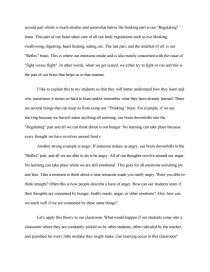Creating a Non Threatening Environment
Essay by Woxman • April 25, 2012 • Essay • 1,276 Words (6 Pages) • 1,760 Views
Creating a Non-threatening Environment
What can a positive environment do for you and your students?
Increase learning, that's what! The studies done by researchers such as Howard Gardner, Leslie Hart and other brain-based researchers show us that there are certain elements that increase the chance of learning. I'm going to use a very simplified explanation and application to the classroom, but if you are truly interested in knowing all about how the brain learns best, I strongly suggest that you look up books written by Eric Jenson, Howard Gardner, Leslie Hart, and Susan Kovalik. My favorite tool for looking up books is Amazon.com because they have such an exhaustive list and are easily searchable.
One of the most important aspects of a positive environment is that it must be non-threatening. What is a non-threatening environment and why is it so important that our classrooms be this way? An environment is non-threatening when students feel comfortable sharing their thoughts, ideas, and dreams with the teacher and also with other students. We want to strive to have an atmosphere in the classroom where no one is judged by anyone else. Every idea is welcomed, no one is ridiculed, no one is fearful of harsh punishments, and no one is put down. Our classroom should also be a place where students can make mistakes and still be cherished.
Now, why is this type of environment important?
Well, simply put, our brains are made of 3 parts. This is called the "Triune Brain". There are technical terms for each part, but here are the terms I use at the beginning of the year to explain this to my students. The largest part of our brain is the "Thinking" part. This is where we learn, store, and retrieve knowledge. Our memories are housed here as well as our creativity. The second part which is much smaller and somewhat below the thinking part is our "Regulating" brain. This part of our brain takes care of all our body regulations such as eye blinking, swallowing, digesting, heart beating, eating, etc. The last part, and the smallest of all, is our "Reflex" brain. This is where our emotions reside and is also mostly concerned with the issue of "fight versus flight". In other words, when we get scared, we either try to fight or run and this is the part of our brain that helps us in that manner.
I like to explain this to my students so that they will better understand how they learn and why sometimes it seems so hard to learn and/or remember what they have already learned. There are several things that can keep us from using our "Thinking" brain. For example, if we are starving because we haven't eaten anything all morning, our brain downshifts into the "Regulating" part and all we can think about is our hunger. No learning can take place because every thought we have revolves around food.v
Another strong example is anger. If someone makes us angry, our brain downshifts to the "Reflex" part, and all we are able to do is be angry. All of our thoughts revolve around our anger. No learning can take place while we are still emotional. This goes for all emotions including joy and fear. Take a moment to think about a time someone made you really angry. Were you able to think straight? Often this is how people describe a haze of anger. How can our students learn if their thoughts are consumed by hunger, bodily needs, anger, or other emotions? Also, how can we teach well if we are consumed by these same things?
Let's apply this theory to our classroom. What would happen if our students come into a classroom where they are constantly picked on by other students, often
...
...



